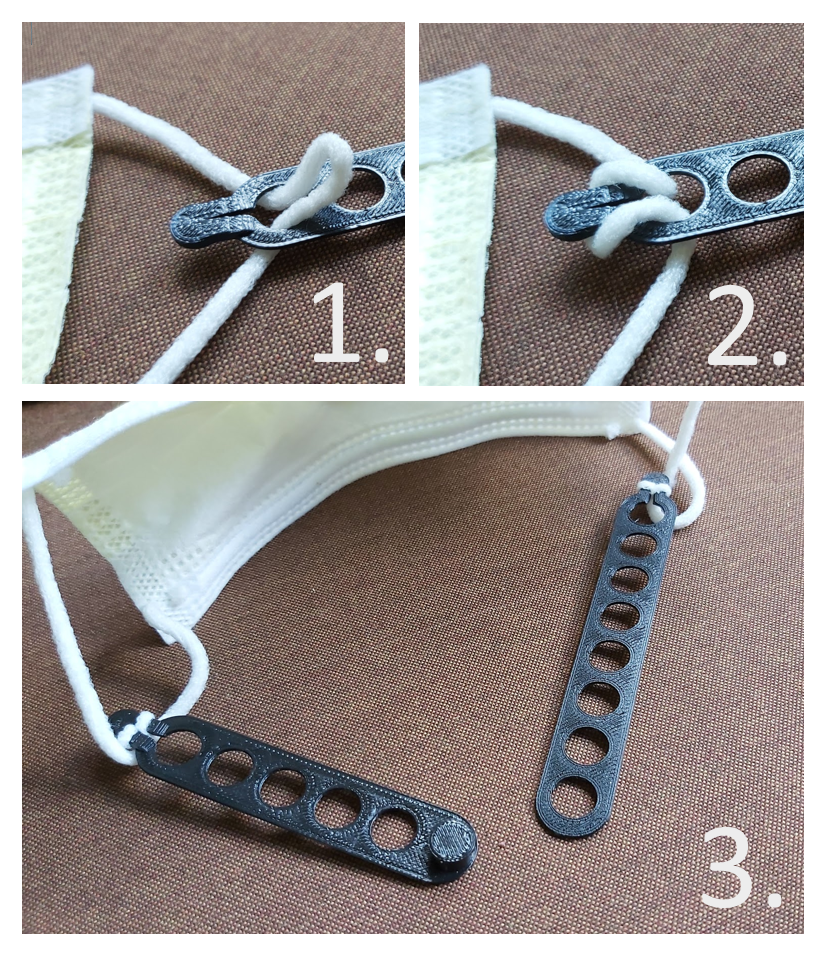
Surgical Mask Ear Saver
thingiverse
Human: Ear-saving surgical mask straps Surgical masks are worn by health care professionals and others throughout the day. The straps wrap behind each ear, causing skin breakdown after several days of wear. This design reduces pressure on the ears. About this design Safer to use: The mask can be donned and doffed without touching it. Less hassle: Attached to the mask means less risk of losing the ear-saver. Fewer tangles: Especially for dense curly hair, no hooks get tangled. Pocketable: The two pieces clip together for storage when not in use. Extendable: If needed, take a button piece from another pair to extend the clip by a few inches. Save the other piece as a spare! Production considerations: Designed to print quickly and on smaller printers. Cons: It takes a moment to attach the mask. Users who change and discard masks frequently may prefer double-sided hook-based designs. Usage instructions Before use: Clean with soap and water, or spray with Hydrogen Peroxide. Put one elastic band through a hole and wrap around. Adjust so that the elastic strap forms a triangle. Repeat for the second piece. Clip behind the head. After use: Unhook (or cut off) the mask, and clip the two pieces together for storage. Discard if broken. Changelog 4/18/2020: Added small catch opposite the button to allow clipping together for pocketability. 4/12/2020: Modified shape of the button and reduction of surface extending past the button, more secure attachment while being less sensitive to print quality affecting the diameter of holes; added attachment point where the mask straps are pulled through. 4/6/2020: Initial two-piece version with holes and button at the end of one piece. Suggested slicer settings (4mm nozzle) Print time: ~12 minutes/pair (5 pairs every 56min on a Flashforge Finder). 0.4mm first layer; 0.3mm subsequent layers. No more than 20mm/sec speed for internal exterior, i.e. the holes. No more than 40mm/sec for external exterior. No more than 15mm/sec speed for top surface, to smooth out imperfections. Suggested Slicer Settings (6mm nozzle) Print time: ~8 minutes/pair (12 pairs every 1h 43min on an Ender 3). 0.55mm first layer; 0.5mm subsequent layers. No more than 20mm/sec speed for internal exterior, i.e. the holes. No more than 40mm/sec for external exterior. No more than 15mm/sec speed for top surface, to smooth out imperfections. Friendly Suggestions PLA works great, but PETG is acceptable. If using PETG, expect a fair bit more stringing, which may get tangled in hair if not removed in post-processing. Any color is fine. When creating a layout, leave 1-2mm between parts. Locate buttons close together on the build plate to avoid unwanted X-Y travel when printing the buttons. Post-processing Clean with soap and water, let dry. Put pre-connected pairs in small plastic bag. Add instructions inside the bag, with text facing out (see printable example below).
With this file you will be able to print Surgical Mask Ear Saver with your 3D printer. Click on the button and save the file on your computer to work, edit or customize your design. You can also find more 3D designs for printers on Surgical Mask Ear Saver.
